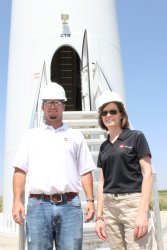Wind is Powering Career Opportunities
Environmental lawyer Philip Warburg is the author of Harvest the Wind, an authorative book on the wind power industry. His book makes a powerful case for greater investments in sustainable energy technology and projects. Thousands of new jobs have already been created in the wind energy sector. This fact is driven home by Warburg in his book.
We tracked down Warburg, who was kind enough to discuss Harvest the Wind, sustainable energy careers, and the wind and solar power industries.
Tell me a little bit about yourself?
A lawyer by training, I’ve spent many years working on environmental issues, most recently as president of the Conservation Law Foundation, a multi-state environmental advocacy group in New England.
What motivated you to write Harvest the Wind?
When I was at the Conservation Law Foundation, I supervised a team of lawyers who were working to get wind farms such as the offshore Cape Wind project responsibly sited in New England. I found it frustrating and disappointing that a project like Cape Wind – potentially the region’s largest wind farm – was being blocked by powerful politicians and industrialists, largely because they opposed any visual encroachment on their open ocean views. I set out to explore other parts of the country where I knew wind power was getting a much more positive reception. I wrote the book because I wanted readers to recognize the significance of this technology in creating American jobs and making America a real player in the battle against climate change.
Is wind a viable, long-term “job creator” … will the industry continue to expand and at what rate?
The National Renewable Energy Laboratory, in June 2012, came out with a study projecting that we could be getting nearly half our total power needs nationwide from wind and solar by mid-century. An earlier Department of Energy report set out a plan for getting us to 20% reliance on wind by 2030, and it projected that, as we approach that date, well over a quarter of a million people will find employment in jobs in or related to the wind industry. Wind power today employs about 75,000 Americans in jobs ranging from equipment manufacturing and construction to the operation and maintenance of wind farms.
The wind industry is creating entry-level job opportunities (i.e., Wind Tech) as well as positions for highly educated individuals. What are the biggest needs currently, and where are the training / educational opportunities?
Skills in electrical and mechanical engineering, hydraulics, electronic data management, and finance are vital to the wind industry. Some of the programs best tailored to wind power careers are at community colleges in areas where wind farms have proliferated. Cloud County Community College in Concordia, Kansas, is one; Iowa Lakes Community College in Estherville, Iowa, is another. These programs and several other programs like them, offering two-year associates’ degrees in wind technology, are great launching pads for careers in this field.
What are some compelling reasons for people to investigate wind as a career choice?
So many of the workers I met in researching my book are proud to be helping America move to a more sustainable, energy-independent future. On a more practical level, people appreciate the fact that wind farms are creating lots of good, well-paying jobs in rural areas where new sources of employment are hard to find.
Geographically speaking, where are the “wind energy job hotspots” in the US and abroad?
If you look at a wind map of the United States, you will see that a broad swath running from the Dakotas on down through Texas has some of our best wind resources. But we have winds sufficient to support profitable and productive wind farms across much of the country. It’s been estimated that we could produce ten times our current total power needs from wind by tapping only our stronger land-based wind resources. Throwing offshore wind into the bargain, that multiplier goes up to about 14 times our current electricity demands.
Do you see the offshore wind energy sector picking up steam or will the majority of opportunities remain on the prairies and grasslands (so to speak)?
So far the cost of offshore wind projects remains well above onshore wind farms, but in the windy North Atlantic off our Northeast seaboard, the benefits of installing offshore turbines close to major metropolitan “load centers” are obvious. Large-scale offshore wind farms are successfully operating in the UK, Denmark, Germany, and other European nations. 
I don’t want to get too far off track, but aside from wind, what are the other up-and-coming renewable energy sectors?
With the price of solar panels dropping dramatically, solar energy has become a major jobs creator in the past year or two. Wind now provides about 6% of America’s power, and solar has yet to break the 1% threshold, but that will soon change as homeowners, businesses, and public institutions get on the solar bandwagon. According to industry estimates, solar energy has already created about 100,000 American jobs.
Tell us about your blog and future writing plans.
I continue to write about wind and the rollout of Harvest the Wind on my blog, but I’m now spending most of my time researching my next book – about solar energy.
KEEPING TABS ON PHILIP WARBURG:
Book Title: Harvest the Wind
Website: https://philipwarburg.com/
Take a Listen: Warburg Radio Interview


 Teach English in Asia
Teach English in Asia  Cruise Ship Jobs
Cruise Ship Jobs  Alaska Fishing Industry Jobs
Alaska Fishing Industry Jobs  Sharing Economy / Gig Economy
Sharing Economy / Gig Economy